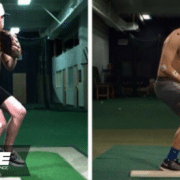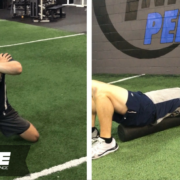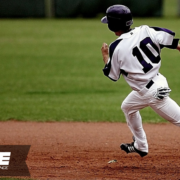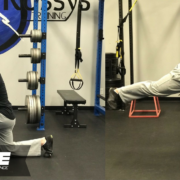3 Drills to Enhance the Rhythm of the Baseball Swing
A baseball swing is an intricate series of movements that need to be correctly timed together to optimize the swing outcome.
The energy of the swing begins at the bottom and works up through the body. This is then transferred into the bat, then the ball.
An athlete needs to generate force from the ground. As in all rotational sports, this is initiated at the pelvis.
As the hips open for the swing, the torso follows next. This is then followed by the lead shoulder and finally the bat. Each region subsequently moves faster than the one prior to it.
This ideal sequence allows each region to build speed on the region below it. This movement pattern facilitates the summation of energy on each level.
Consequently, as each body region builds speed the area below it slows down.
With this sequencing the baseball swing is a quick and powerful movement.
The Science of a Powerful Baseball Swing
Aside from the sequencing mechanics, the stretch shortening cycle plays a significant role in this power development.
The stretch shortening cycle triggers maximal muscle activation in a minimal amount of time. It is the combination of a countermovement stretch at the tendons and the body’s involuntary response to being stretched.
In the world of strength and conditioning, this is the cornerstone for plyometric exercise.
A simple example is a box jump. The athlete quickly drops down before exploding up and onto the box.
The stride in a baseball swing occurs simultaneously with the loading of the upper body. In the cage, we cue hitters to point the knob of the bat to the catcher in this load.
This movement of the upper body separating from the lower body is the countermovement stretch. The explosive movement in the opposite direction (towards the pitcher) occurs next.
To maximize the benefit of weight shift, correct timing with the pitch is necessary. Load too early or too late and the hitter’s power and timing with the pitch are gone. Therefore, it is vital to get the lead foot down in time, not early or late.
Practice with a Tee
The tee provides a controlled practice setting to refine swing timing. Hitters should be encouraged to hone their swings off a tee prior to any machine or live swings.
Even during a game tees should be available for hitters to settle in their swing between innings. In a game, the on-deck circle provides another opportunity for hitters to sync their swing timing.
Once a hitter has their swing ready, their attention in the on-deck circle should shift to timing their swing with the pitcher’s rhythm.
This is common practice for experienced players, however, younger players will need to be educated on this use of the on-deck circle.
Drills to Enhance the Rhythm of the Baseball Swing
To develop a better baseball swing, try these 3 drills.
Step Through Swing Drill
The first drill to restore the swing’s rhythm is a step through swing.
The hitter assumes their regular stance 3-4 feet deeper in the batter’s box than normal. Next, the hitter crosses over their back foot and plants it at the normal location.
Their lead leg strides as their hands load back, which creates the lead into a normal swing.
The key movement and moment in this drill is the stride of the lead leg with appropriate separation/load of the hands. Coaches can cue their athletes to feel the stretch from their lead hip through their torso into their shoulders.
An important point is that this drill is not a softball slap. The athlete should not rush the tempo of the drill by running through it.
Step Back Hitting Drill
The second drill is referred to as a step back. In their normal set up, the hitter steps their back foot to their lead foot, then steps the trail foot back to its normal positioning and swings.
Again, the focus is on developing an easy tempo in the swing. The right foot lands to immediately trigger the step and separation into load.
However, there should not be a stop in motion. Any stoppage will allow a loss of energy from the stretch reflex.
Lead Leg Hook Hitting Drill
The third drill is a lead leg hook. In their normal batting stance, the hitter takes their lead leg and crosses it over the front of their back leg.
From here, the hitter strides to their normal distance and swings.
The key coaching point is to only move the lower body while preventing the upper body from moving forward prematurely. This would lead to lunging at the ball.
As their lead leg is striding, their hands are moving into the loaded position. Similar to the above drills the hitter should feel that core stretch.
Swinging a baseball bat may not be dancing, but hitters know what an out of rhythm swing feels like.
Hitters also know the awkward feeling of pounding a ground ball into the grass 10 feet in front of home plate or the loss of pop on a grooved pitch. Additionally, coaches know what lack of timing in a swing looks like.
The key to any swing is to properly time and load the lower body for energy to transfer to the upper body.
Off a tee, these three drills should be used frequently to restore the rhythm of a swing.
Barb Kutch
Latest posts by Barb Kutch (see all)
- 3 Drills to Enhance the Rhythm of the Baseball Swing - February 12, 2018










Leave a Reply
Want to join the discussion?Feel free to contribute!